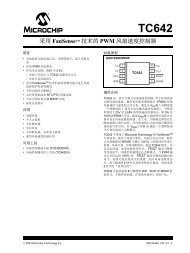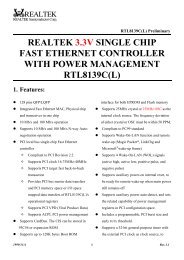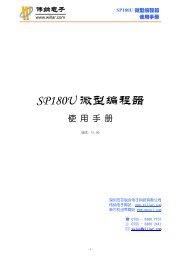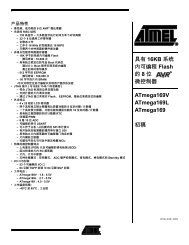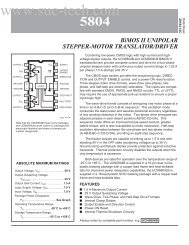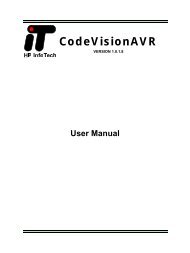Nios II Processor Reference Handbook
Nios II Processor Reference Handbook
Nios II Processor Reference Handbook
You also want an ePaper? Increase the reach of your titles
YUMPU automatically turns print PDFs into web optimized ePapers that Google loves.
Software Programming Modelcontrol RegisterThe control register has four defined bits, as shown in Table 8–5.Table 8–5. control Register BitsBitNameRead/Write/ClearDescription0 ITO RW If the ITO bit is 1, the timer core generates an IRQ when the statusregister’s TO bit is 1. When the ITO bit is 0, the timer does not generateIRQs.1 CONT RW The CONT (continuous) bit determines how the internal counter behaveswhen it reaches zero. If the CONT bit is 1, the counter runs continuously untilit is stopped by the STOP bit. If CONT is 0, the counter stops after it reacheszero. When the counter reaches zero, it reloads with the 32-bit value storedin the periodl and periodh registers, regardless of the CONT bit.2 START (1) W Writing a 1 to the START bit starts the internal counter running (countingdown). The START bit is an event bit that enables the counter when a writeoperation is performed. If the timer is stopped, writing a 1 to the START bitcauses the timer to restart counting from the number currently held in itscounter. If the timer is already running, writing a 1 to START has no effect.Writing 0 to the START bit has no effect.3 STOP (1) W Writing a 1 to the STOP bit stops the internal counter. The STOP bit is anevent bit that causes the counter to stop when a write operation isperformed. If the timer is already stopped, writing a 1 to STOP has no effect.Writing a 0 to the stop bit has no effect. Writing 0 to the STOP bit has noeffect.If the timer hardware is configured with the Start/Stop control bits optionturned off, writing the STOP bit has no effect.Note:(1) Writing 1 to both START and STOP bits simultaneously produces an undefined result.periodl & periodh RegistersThe periodl and periodh registers together store the timeout periodvalue. periodl holds the least-significant 16 bits, and periodh holdsthe most-significant 16 bits. The internal counter is loaded with the 32-bitvalue stored in periodh and periodl whenever one of the followingoccurs:■ A write operation to either the periodh or periodl register■ The internal counter reaches 0The timer’s actual period is one cycle greater than the value stored inperiodh and periodl, because the counter assumes the value zero(0x00000000) for one clock cycle.8–8 Altera Corporation<strong>Nios</strong> <strong>II</strong> <strong>Processor</strong> <strong>Reference</strong> <strong>Handbook</strong> September 2004



